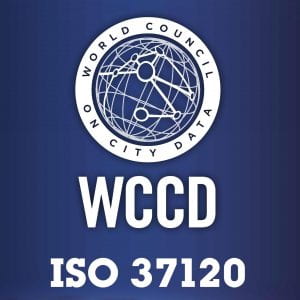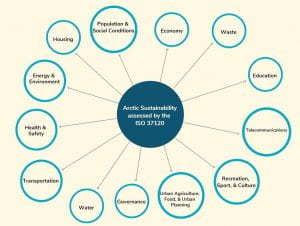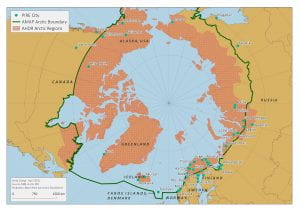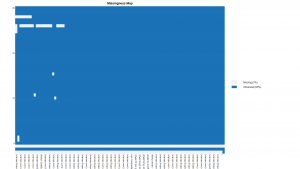The ISO 37120 Standard
- Created by the International Organization for Standardization (ISO)
- Developed by technical committees made up of urban researchers and experts
- The standard’s first version was published in 2014 and an updated version was published in 2018
- Meant to apply to cities globally
- Covers 19 sustainability domains
- Economics, Education, Energy, Environment and Climate Change, Finance, Governance, Health, Housing, Population and Social Conditions, Recreation, Safety, Solid Waste, Sport and Culture, Telecommunications, Transportation, Urban/Local Agriculture and Food, Urban Planning, Wastewater, Water
- Consists of 45 core indicators, 59 supporting, and 24 profile
To learn more about the ISO 37120, see here.
To read an article written by our colleagues focusing on how well the standard applies to Arctic cities, see here.
Arctic PIRE Database
One of our main goals is to develop an Arctic Urban Sustainability Index which can be used to measure the effects of human activity, climate change, inform policy measures that can help mitigate these effects, and assess progress towards sustainable solutions in these cities.
It is important that we make our findings and database open and accessible to the public, in an effort to encourage professionals, policy-makers, city officials, and students to collaborate and work on developing sustainable solutions to the challenges facing Arctic cities. If you are interested, please take a look at our database so far by clicking on the button above.
NOTES: Data sources and calculation steps based on the ISO standard are located in the cell notes. Where city level data (white cells) could not be found, green shows national-level data, purple shows regional, blue shows county, orange shows state (Alaska), red shows imputed data.
In our project, we have chosen 46 Arctic and near-Arctic cities (see map for context) to include. Since 2018, we have collected data according to the ISO 37120 standard, storing what we have found in our own database. Our primary sources for data include municipality reports, various City Department websites, national statistical databases, and in some occasions, direct communication with city officials. This ‘missingness’ map below depicts the completeness of our database at the end of the data collection phase. Out of the 128 ISO indicators for sustainability defined by the standard, we were able to find data for 101 indicators in full.* In no way is this the “end” of data collection, as we believe that this database should consistently be updated to reflect the cities. It is important to recognize that our data is imperfect. There are numerous flaws we have to keep in mind because we ran into many challenges. For example, cities frequently lack precise data and do not perform regular tracking. Where there is data, each city is likely to measure and collect data in a different manner. Our aim was to find city-level data, but where that was not possible, we found county-level, regional, or national figures. This solution is not the best equipped to reveal city-level sustainability, however, we hope that in time, better data can be collected and applied. We see this as an important first step to include Arctic and near-Arctic cities in the rising global discussion on sustainability.
*With the exception of some points where data imputation was to compensate for lack of data.
Moving Forward
A crucial next step that follows data collection is performing analyses in order to tidy up, model, and reveal information which can be used for decision-making. Aside from comparing and contrasting cities’ and their respective sustainable performances, we are interested in the opportunities presented with tracking and measuring progress in the many realms of sustainability. We also hope to further investigate the effectiveness of the ISO 37120 as it applies (or does not apply) to the 46 PIRE cities. Are there indicators, crucial to the sustainability of Arctic cities, that are not included? Which indicators are relevant to Arctic cities? How can this standard, and other sustainability standards, improve in assessing and determining progress, shortcomings, and areas of potential? These are some of the questions we aim to investigate in the data analysis phase.
The below is a preliminary example of how we plan to use the data to depict holistic sustainability city-to-city. It will be included in an upcoming publication done by our colleagues which compares the sustainability performance of Russian Arctic cities to non-Russian Arctic cities. The summary radar chart plots the average z-score values for each indicator and groups them by Russian cities (dark red) and non-Russian cities (black), highlighting a general point of comparison between the two groups:
Indicator Key:
- Percentage of population who are males aged 65+
- Percentage of waste recycled
- Waste production per capita
- Gini coefficient
- Number of university students per 100,000 population
- Number of internet connections per 100,000 population
- Number of businesses per 100,000 population
- Percentage of energy derived from renewable sources
- Energy consumption per capita (in gigajoules)
- Number of cultural institutions and sporting facilities per 100,000 population
- Capital spending as a percentage of total expenditures
- Debt service ratio
- Number of doctors per 100,000 population
- Number of hospital beds per 100,000 population
- Population dependency ratio




